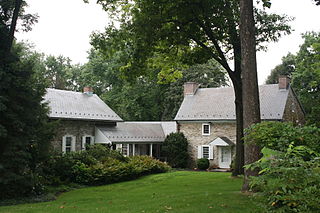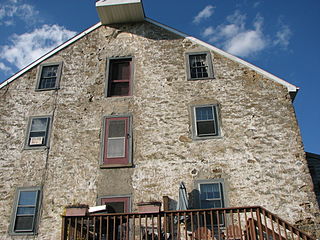
Harriton House, originally known as Bryn Mawr, is a historic house on the Philadelphia Main Line, most famously the residence of Founding Father Charles Thomson, the secretary of the Continental Congress. It was originally built in 1704 by Rowland Ellis, a Welsh Quaker, and was called Bryn Mawr, meaning high hill. The modern town of Bryn Mawr is named after the house, and the National Register of Historic Places has it listed under the original name.

Geeting Farm is a historic home located at Keedysville, Washington County, Maryland, United States. It is a two-story, five-bay log dwelling resting on low fieldstone foundations, with a one-story, three-bay stone addition. Numerous sheds and outbuildings are located near the house. The house was built by George Adam Geeting [1741-1812], who settled on this land near Little Antietam Creek after immigrating to the English Colony of Maryland in 1759 from his native Prussia. Geeting farmed his land and taught in a log schoolhouse nearby which became a regular preaching appointment for services held by Rev. Philip William Otterbein, one of the founding leaders of the United Brethren in Christ, the first denomination organized in the United States of America. In the mid-1770s, Geeting erected a meetinghouse which later became known as Mount Hebron Church, the first structure built expressly for services of the future United Brethren in Christ denomination. Salem United Methodist Church in Keedysville is the successor to the Mount Hebron Church and Geeting Meetinghouse. Getting himself was ordained a minister of the German Reformed Church in 1788 and traveled extensively through Western Maryland, Virginia, and Pennsylvania as an itinerant preacher. On September 25, 1800, George Adam Geeting attended the first conference of the United Brethren in Christ at the home of Peter Kemp near Frederick, Maryland. It was at this conference that the United Brethren in Christ was formally organized as a denomination and took its name. Geeting continued serving as a minister for the new church, acted as secretary of the denominational conference, and served as a bishop of the United Brethren in Christ briefly in 1812 before his death.

Townsend House, also known as Lundale Farm, is a historic home located near Pughtown in South Coventry Township, Chester County, Pennsylvania. It was built in three phases. The oldest section dates to 1796, with additions made in the early 19th century, and in 1950. The main house was built in the first two phases and is a 2+1⁄2-story, five-bay, random fieldstone structure coated in stucco. It has a gable roof and a brick chimney at the west gable end. The 1950 addition is a 2+1⁄2-story structure attached at the east end. Also on the property is a stone springhouse dated to the early 18th century.

Newtown Presbyterian Church, also known as Old Presbyterian Church of Newtown, is a historic Presbyterian church complex and national historic district in Newtown, Bucks County, Pennsylvania.

Centre Mills is a historic grist mill located at Miles Township, Centre County, Pennsylvania. It was built in 1802-1803, and is a two-story fieldstone building, with a basement and attic. It measures 44 feet, 10 inches, by 58 feet, and has a gable roof. Also on the property are a barn, stone house, and miller's house. The stone house was built in 1813, and is a two-story stone dwelling, measuring 40 feet by 30 feet, with a two-story frame addition. It features a porch supported by Corinthian order columns. The miller's house is a frame dwelling on a stone foundation. The stone house is operated as a bed and breakfast.

Boonecroft is a historic homestead in Exeter Township, Berks County, Pennsylvania. It includes the remains of the log cabin built in 1720 by Quaker settler George Boone III. The remains consist of a chimney and fireplace and are commemorated by a stone marker erected in 1925. The log cabin burned in 1924. The adjacent stone farmhouse was built in 1733, and is a 2½-story Colonial English style structure. It is built of fieldstone with sandstone quoins, and has a slate-covered gable roof. It has a one-story stone addition. Also on the property are the contributing guesthouse / spring house, smokehouse, and barn. The property is considered the ancestral home of the Boone family in America, which includes frontiersman Daniel Boone, grandson of George Boone III. Daniel Boone was born at the nearby Daniel Boone Homestead.

Sotcher Farmhouse, also known as "Three Arches," is a historic home located at Fairless Hills, Falls Township, Bucks County, Pennsylvania. The original house was built about 1712, with substantial additions made about 1760 and 1806. The original house was likely a one-story, stone structure. The 1760 section is a two-story, three bay fieldstone structure. The 1806 addition completely enveloped the 1712 house. It is a 2+1⁄2-story, four bay fieldstone structure that incorporates the house's distinctive three arches.

Morgan James Homestead is a historic home located at New Britain Township, Bucks County, Pennsylvania. The original Federal period house was built about 1783, and consists of a two-story, fieldstone main house with a one-story rear addition. The rear addition contains a kitchen and smokehouse. A three-story, stuccoed stone addition with a gable roof was built about 1840. Also on the property is a large Pennsylvania bank barn.

John Burroughs Homestead, also known as Shady Hill and the Lieutenant Colonel James Hendricks Headquarters, is a historic home located at Taylorsville, Upper Makefield Township, Bucks County, Pennsylvania. It is a house dated to the 18th century and built in four sections. The oldest section is a 2+1⁄2-story, uncoursed fieldstone structure. The second section is a 2+1⁄2-story, coursed fieldstone structure. The third section is a two-story, random-coursed fieldstone structure, and the fourth section is a small, one-story frame vestibule. Also on the property are a contributing 2+1⁄2-story, fieldstone carriage house, tool shed, and stone-and-frame caretaker's cottage.

Squire Cheyney Farm is a historic farm and national historic district located in Thornbury Township, Chester County, Pennsylvania. The district encompasses two contributing buildings, three contributing sites, one contributing structure, and contributing object. They are the farmhouse, barn, ruins of a granary, remains of an ice house, a spring house (1799), stone retaining wall, and family cemetery. The house was built in four periods, with the oldest dated to about 1797. The oldest section is a 2 1/s-story, three bay, stuccoed stone structure with a gable roof. The additions were built about 1815, about 1830, and about 1850, making it a seven-bay-wide dwelling. It is "L"-shaped and has a slate gable roof. During the American Revolution, Thomas "Squire" Cheyney [II] informed General George Washington during the Battle of Brandywine that the British were flanking him to the north. He was later appointed to the Pennsylvania Ratifying Convention to ratify the United States Constitution. The site is now a township park known as Squire Cheyney Farm Park.

Goodwin Acres is a historic home located in East Goshen Township, Chester County, Pennsylvania. It was built about 1736, with two additions made about 1749 and about 1840. It is a 2+1⁄2-story, four-bay by one-bay, coursed fieldstone dwelling with a gable roof with dormers. The west addition is a low, one-story structure with a gently pitched gable roof. The east addition is one-story. The additions are unified to the main structure by a porch. An enclosed porch and library were added in 1941. Also on the property are a stone-and-frame Pennsylvania bank barn and a stone spring house.

Simon Meredith House is a historic home located in South Coventry Township, Chester County, Pennsylvania. It was built in two major phases. The oldest section was built in the early 18th century. It is a 2+1⁄2-story, two-bay, stuccoed fieldstone structure with a gable roof. The larger Federal-style addition was made on the east end. It is 2+1⁄2 stories, four bays wide, and of stucco-over-stone construction. The house features a full-width, one-story porch.

Nathan Michener House is a historic home located in South Coventry Township, Chester County, Pennsylvania. It was built about 1813, and is a 2+1⁄2-story, four-bay by two-bay, fieldstone dwelling a transitional Greek Revival style. It has a gable roof, end chimneys, and features massive corner quoins. It also has a one-story, fieldstone sunporch with a pyramidal roof.

The Hockley Mill Farm, also known as Mt. Pleasant Mills and Frank Knauer Mill, is an historic home and grist mill which is located in Warwick Township, Chester County, Pennsylvania.

Philip Rogers House, also known as Penn Wick, is a historic home located in Warwick Township, Chester County, Pennsylvania. It was built about 1750, and is a 2+1⁄2-story, five-bay-by-two-bay, random fieldstone dwelling. It has a gable roof with gable end chimneys. A 2+1⁄2-story kitchen wing was added before 1825.

Jacob Winings House and Clover Mill is a historic clover mill and home located in Warwick Township, Chester County, Pennsylvania. The house was built by 1796, and is a 2+1⁄2-story, random fieldstone structure, six bays wide by two bays deep. It has a gable roof and a porch added in the late 19th century. The mill is a small, 2+1⁄2-story, banked stone structure with a gable roof.

There are two historic mills called Warwick Mills. The older of the two is in Pennsylvania and is no longer running. The other is in New Hampshire, and is still manufacturing today.

Fagley House is a historic home located in West Pikeland Township, Chester County, Pennsylvania. It was built in 1860, and is a three-story, five bay by two bay, random fieldstone structure. It has a gable roof and a one-story porch supported by four Doric order columns.

Nicholas East House is a historic home located in West Vincent Township, Chester County, Pennsylvania. The original section was built in 1820, and is a 2+1⁄2-story, five-bay by two-bay, random fieldstone structure. It has a gable roof and gable end chimneys. It has a two-story rear addition, with a one-story addition attached to it. The front facade features a full-width porch.

Strickland-Roberts Homestead, also known as Bryncoed Farm, is a historic home located in West Vincent Township, Chester County, Pennsylvania. The original section dates to about 1800, and is a two-story, five-bay by one-bay, fieldstone structure. It has a gable roof, small shed-roofed porch, and terrace. A 2+1⁄2-story, four-bay, random fieldstone addition was designed by R. Brognard Okie and built in 1929. Also on the property is a contributing bank barn dated to 1873. The house was purchased by U.S. Supreme Court Justice Owen J. Roberts in 1927, and is where he died in 1955.
























